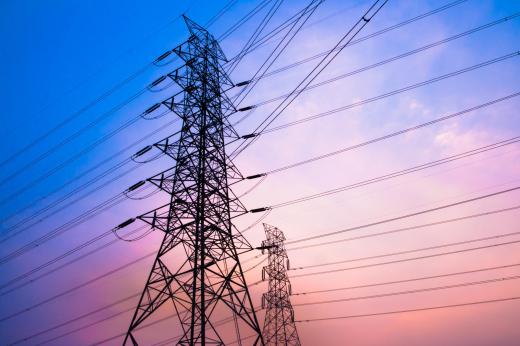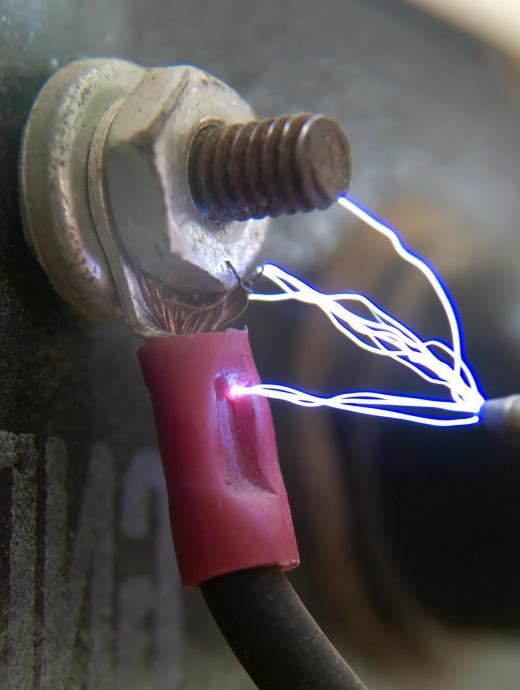What is an Insulator?
An insulator is a material or method that restricts the transfer of either heat or electricity. In the case of heat, thermal insulators work by reducing the rate heat can travel through a space. Generally, they use specific materials and will keep heat-carrying matter from moving. In the case of electricity, electrical insulators confine an electric current to a designated path. They typically work by using a material with many outer elections, a condition that will cause low electrical conductivity.
The first sense of an insulator is the thermal sense. A thermal insulator helps keep an object at the same temperature, whether hot or cold. It typically works by addressing either conduction or convection, which are two modes of heat transfer. Conduction is heat that moves through a material whose atoms are stationary; this type refers to the heat that can travel through a piece of solid metal. Convection, on the other hand, is internal heat carried with moving matter; this occurs when wind carries heat away from one’s body.

A thermal insulator functions by slowing the rate heat can move through a region. The rate of conductive heat transfer is proportional to a material property called thermal conductivity—copper, for example, transfers heat quickly because of its high-thermal conductivity. A good insulator, therefore, has a low-thermal conductivity. In fact, air has a low conductivity, but it tends to move around a lot. Using a blanket works as a thermal insulator because it forces air to transfer heat through conduction instead of convection.

The second sense of an insulator is electrical. An electrical insulator does not permit an electric current to flow through it because it has a low electrical conductivity. Many factors affect electrical conductivity, including temperature, but elements tend to have either high or low conductivity. This results because different elements have a different number of outer electrons, which changes how easy it is to free those electrons. Metals, for example, tend to have high conductivity because their outer electrons are easy to free.
Many other elements and compounds have a high number of outer electrons, making them difficult to free. This is generally the case for glass, plastic, porcelain and rubber. Therefore, these materials are used in electrical appliances to keep electrical currents on a restricted path. Low electrical conductivity is also a property of air and many other gases. Air is the only insulator used on raised power lines.
AS FEATURED ON:
AS FEATURED ON:












Discussion Comments
@anon145343: Absolutely correct.
@jcraig - That is a really good question. Obviously, we know that fiberglass insulation has some sort of property that makes it a better insulator than regular air or we wouldn't use it. I'm just taking a guess, but I would say that fiberglass insulation works because it creates pockets of air inside of the material which gives the fiberglass time to stop the flow of heat.
An example would be if you were trying to stop heat from leaving your house. Heat always goes from hot to cold, so without insulation, there would be a constant exchange between the air in the house, in the wall, and outside. With insulation, the heat would have to warm up the fiberglass and air pockets first, before it was able to interact with the colder air outside. That way it serves as a kind of buffer between the two temperatures.
I think this is probably pretty close to being accurate, but if I'm wrong hopefully someone else can correct me.
How then does fiberglass wall insulation work? I guess it would fall into the category of stopping conduction, but if air is such a good insulator, why not just use the air inside the wall, since the air is not moving to help with convection?
Also, aren't certain gases more resistant to heat change than regular air? I think now in a lot of double pane windows, they pump in some type of gas that absorbs heat better. I want to say it is argon, but I couldn't be sure about that.
@JimmyT - As far as the porcelain insulators go, I have seen them used as electric fence insulators. The purpose of the insulators is when an electrified wire is attached to something like a normal chain link fence. In most cases, you just want to wire to carry the charge, not the whole fence. The wire is usually strung through a plastic bracket, but older fences used porcelain.
I have also seen ceramic insulators used on municipal power lines. I'm not sure what their exact purpose is, but I know they are used.
Isn't it true that as an electrical current gets stronger, the materials used to insulate the wire have to be more durable? For example, if you just used a thin, cheap piece of plastic to insulate a large power line, wouldn't the plastic react with the line causing the plastic to melt? I know I've seen instances when electrical wires have melted the insulating material. I'm just wondering what causes it.
Interesting, I guess I never really thought about why certain materials are able to carry an electric charge and some can't.
Does anyone know what electrical tape is made of and why it doesn't carry an electric charge? It feels like it is made of some type of plastic-like material, but it might have some rubber mixed in too, since it can stretch a little bit.
Something else I found myself wondering while I was reading the article was what uses a porcelain insulator. I can not think of anything I have ever seen that uses any type of porcelain. Does anybody know?
Simple, but covers all the things that's necessary. Great job.
Post your comments